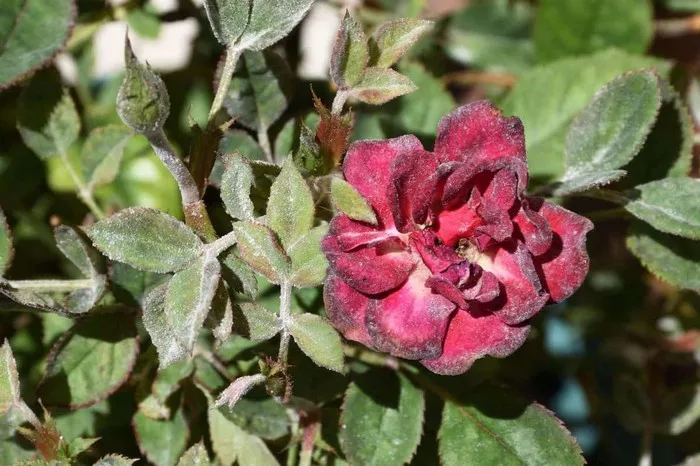Powdery mildew can wreak havoc on flowering plants, causing unsightly white patches and potentially stunting growth or even killing the plant. This fungal disease thrives in warm, humid conditions, making it a common nuisance for gardeners, particularly during the flowering stage of plant growth. However, with proper knowledge and proactive measures, it’s possible to effectively manage and eliminate powdery mildew, safeguarding your flowering plants and ensuring a healthy garden.
Understanding Powdery Mildew:
Before delving into control methods, it’s essential to understand what powdery mildew is and how it affects plants during the flowering stage. Powdery mildew is caused by various fungal species, with each species typically targeting specific host plants. The characteristic white powdery growth appears on the surfaces of leaves, stems, and flowers, often accompanied by yellowing or browning of affected plant tissue.
This fungal disease spreads through airborne spores, thriving in environments with high humidity and moderate temperatures. During the flowering stage, plants are particularly susceptible to powdery mildew due to increased foliage density and favorable conditions for fungal growth. Left unchecked, powdery mildew can severely impact flower development and overall plant health, leading to reduced yields and diminished aesthetic appeal.
Effective Strategies for Powdery Mildew Control During Flowering:
1. Cultural Practices and Preventive Measures:
Promote good airflow: Proper air circulation is essential for reducing humidity levels and inhibiting powdery mildew growth. Prune overcrowded foliage and space plants appropriately to allow for adequate airflow throughout the garden.
Maintain plant hygiene: Remove and dispose of any infected plant debris promptly to prevent the spread of powdery mildew spores. Regularly clean gardening tools and equipment to minimize contamination.
Water management: Avoid overhead watering, as excess moisture on foliage creates favorable conditions for powdery mildew development. Instead, water plants at the base or use drip irrigation to keep foliage dry.
Site selection: Choose planting locations with sufficient sunlight and well-drained soil, as these conditions help discourage powdery mildew formation. Avoid planting susceptible species in shaded or poorly ventilated areas.
2. Biological Control Methods:
Beneficial microorganisms: Introduce microbial-based products containing antagonistic fungi or bacteria known to suppress powdery mildew. These biological agents can help establish a competitive environment, reducing the incidence of fungal infections.
Predatory insects: Encourage populations of natural predators such as ladybugs and lacewings, which feed on powdery mildew-infected plants and help control its spread. Consider releasing these beneficial insects into the garden as part of an integrated pest management (IPM) approach.
3. Chemical Treatments:
Fungicidal sprays: Apply fungicidal products specifically formulated to target powdery mildew, following label instructions carefully. Choose products containing active ingredients such as sulfur, potassium bicarbonate, neem oil, or horticultural oils, which effectively suppress fungal growth without harming flowering plants.
Rotation of fungicides: To prevent the development of resistance, alternate between different classes of fungicides with distinct modes of action. Rotate chemical treatments according to recommended intervals and avoid over-reliance on a single product.
4. Homemade Remedies and DIY Solutions:
Baking soda spray: Mix 1 tablespoon of baking soda with 1 gallon of water and a few drops of liquid soap to create a homemade fungicidal spray. Apply this solution to affected plants every 7-10 days to help control powdery mildew.
Milk solution: Dilute cow’s milk with water in a 1:9 ratio and spray it onto infected plant surfaces. The proteins and enzymes present in milk have been shown to inhibit powdery mildew growth when applied regularly.
5. Cultural Rotation and Plant Selection:
Crop rotation: Practice crop rotation to disrupt the life cycle of powdery mildew fungi and reduce the buildup of inoculum in the soil. Rotate flowering plants with non-host species or those less susceptible to powdery mildew to minimize disease pressure.
Resistant cultivars: Select plant varieties bred for resistance to powdery mildew, as these cultivars exhibit genetic traits that enhance their ability to withstand fungal infections. Consult with local nurseries or extension services to identify suitable resistant varieties for your region.
Monitoring and Integrated Pest Management (IPM):
Regular monitoring is crucial for early detection of powdery mildew symptoms during the flowering stage. Inspect plants thoroughly for signs of infection, including white powdery patches on leaves and stems, distorted growth, and leaf discoloration. Implementing an integrated pest management (IPM) approach allows for a comprehensive strategy that combines cultural, biological, chemical, and physical control methods tailored to specific garden conditions.
Conclusion
Effectively managing powdery mildew during the flowering stage requires a multifaceted approach that addresses environmental conditions, cultural practices, and targeted control methods. By implementing preventive measures, utilizing biological controls, and employing appropriate chemical treatments when necessary, gardeners can mitigate the impact of powdery mildew and safeguard the health and productivity of their flowering plants. With careful attention and proactive management, it’s possible to enjoy a thriving garden free from the constraints of this troublesome fungal disease.


